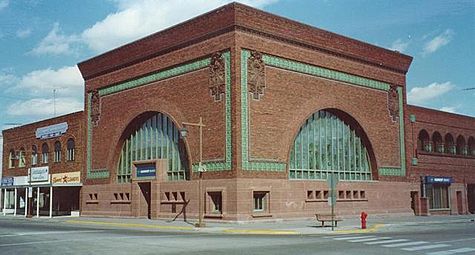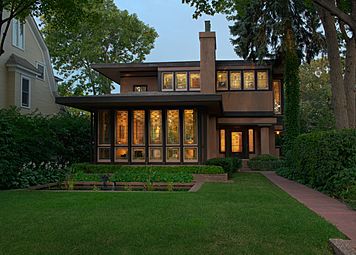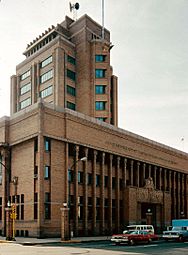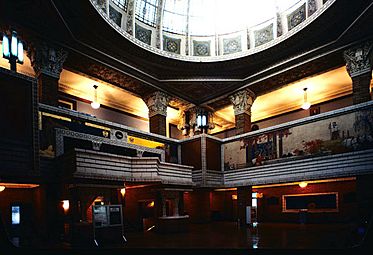George Grant Elmslie facts for kids
Quick facts for kids
George Grant Elmslie
|
|
|---|---|
| Born | February 20, 1869 |
| Died | April 23, 1952 (aged 83) |
| Alma mater | Cornell University |
| Occupation | Architect |
| Buildings | |
George Grant Elmslie (born February 20, 1869 – died April 23, 1952) was an important American architect. He was born in Scotland but moved to the United States. He is known for his work in the Prairie School style of architecture, especially in the Midwest. He worked with famous architects like Louis Sullivan and later became a partner in the firm Purcell & Elmslie.
Contents
Elmslie's Architecture Career
George Elmslie started his journey in architecture by learning from William Le Baron Jenney. Jenney was a pioneer who invented the steel frame for buildings, which is used in many modern structures today.
In 1887, Elmslie joined the office of Joseph Lyman Silsbee in Chicago. Here, he worked alongside other future famous architects like Frank Lloyd Wright and George Maher.
Working with Louis Sullivan
After Frank Lloyd Wright left Silsbee's office, he suggested that Elmslie join him at Adler & Sullivan. This was a very important architecture firm. In 1888, Elmslie started working there. This began a 20-year partnership between Elmslie and Louis Sullivan.
Elmslie became Sullivan's main draftsman, which means he drew the detailed plans for buildings. He was also a key designer of the beautiful decorations, or "ornaments," on Sullivan's buildings. He designed the detailed ornaments for several famous buildings, including:
- The Wainwright Building in St. Louis.
- The Schlesinger & Mayer Department store in Chicago.
- The National Farmers Bank in Owatonna, Minnesota.
Purcell & Elmslie Partnership
The architecture firm known as Purcell & Elmslie was a very successful partnership. It actually started in 1907 as Purcell & Feick, formed by William Gray Purcell and George Feick, Jr.
George Elmslie became friends with Purcell in 1903. Elmslie often gave advice to Purcell & Feick. In 1909, Elmslie officially joined their office in Minneapolis, Minnesota. The firm's name then changed to Purcell, Feick, & Elmslie in 1910.
When Feick left in 1912, the firm became known as Purcell & Elmslie. This partnership lasted until 1921. During this time, Purcell & Elmslie became one of the busiest and most well-known firms in the Prairie School style. They were second only to Frank Lloyd Wright in the number of projects they completed.
After the partnership with Purcell ended, Elmslie continued to work on his own. He sometimes worked with other architects like Lawrence A. Fournier and William S. Hutton. He designed many banks, train stations, and other commercial buildings during the 1920s and 1930s.
Later in his career, as new projects became fewer, he helped William S. Hutton design several schools in Indiana and Illinois. These included the Washington Irving, Oliver Morton, and Thomas Edison Schools in Hammond, Indiana, and Thornton Township High School in Calumet City, Illinois.
In 1947, George Elmslie was recognized for his great work. He was elected a Fellow of the American Institute of Architects. This is a high honor for architects.
Gallery
-
National Farmers Bank in Owatonna, Minnesota (1908)
-
Harold C. Bradley House, Madison, WI, designed by Sullivan and Elmslie (1908–10)
-
Edna S. Purcell House designed by Purcell & Elmslie (1913)
-
Steele, Purcell & Elmslie, Woodbury County Courthouse (1916)
Personal Life
George Elmslie was born on February 20, 1869. Interestingly, he kept his true birth year a secret for most of his life, telling people he was born in 1871. No one is quite sure why he did this.
Elmslie passed away on April 23, 1952. He is buried at Graceland Cemetery in Chicago, a famous cemetery where many important Chicago figures are laid to rest.
Images for kids
See also
 In Spanish: George Grant Elmslie para niños
In Spanish: George Grant Elmslie para niños







